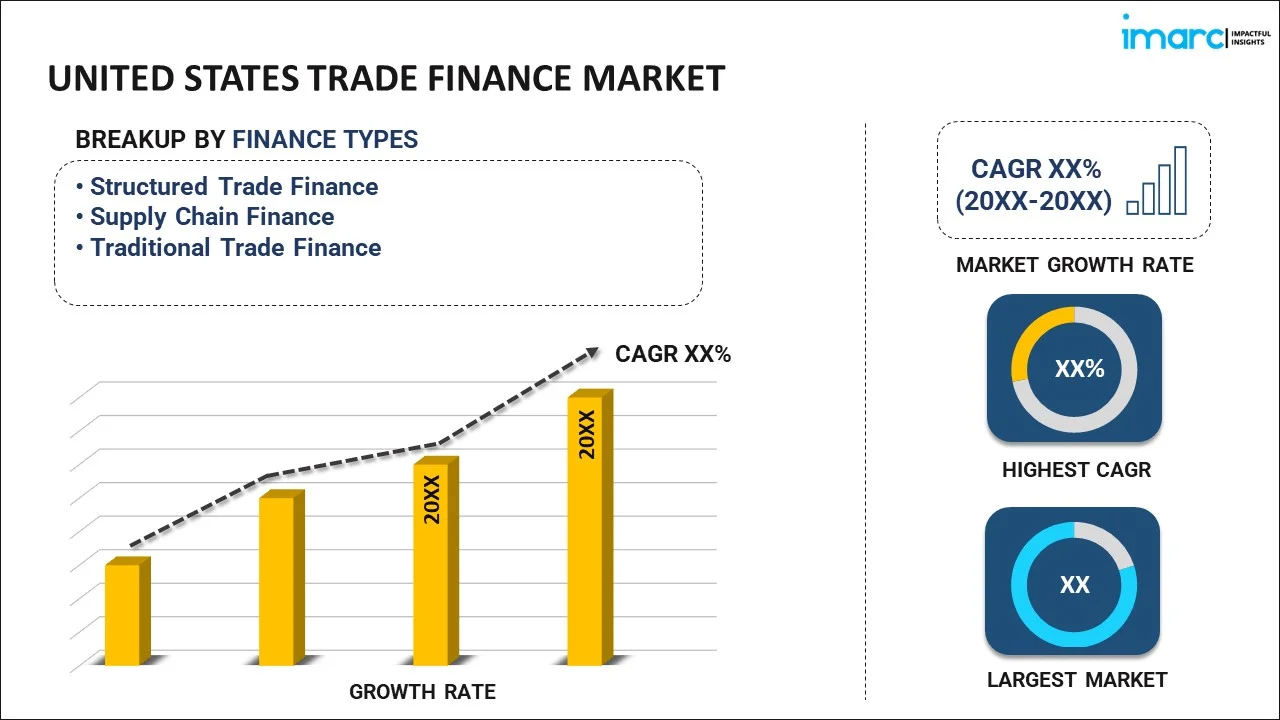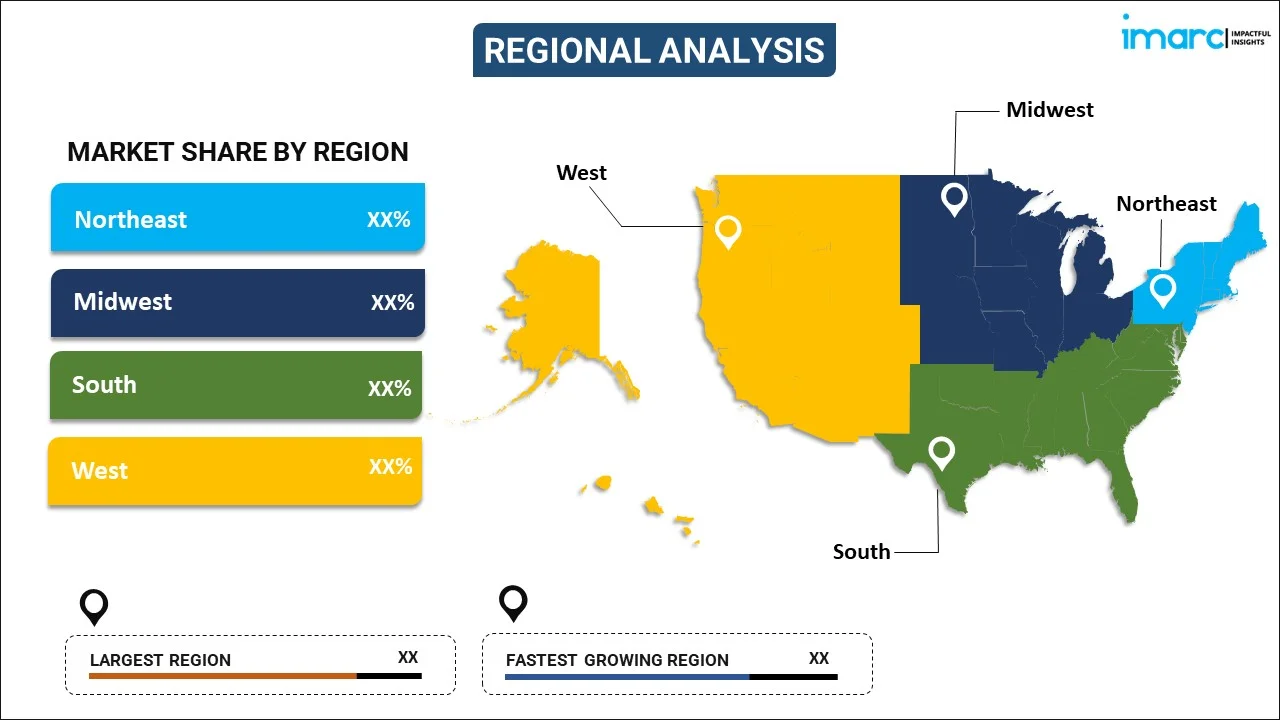
United States Trade Finance Market Report by Finance Type (Structured Trade Finance, Supply Chain Finance, Traditional Trade Finance), Offering (Letters of Credit, Bill of Lading, Export Factoring, Insurance, and Others), Service Provider (Banks, Trade Finance Houses), End-User (Small and Medium Sized Enterprise (SMEs), Large Enterprises), and Region 2025-2033
Market Overview:
The United States trade finance market size reached USD 13.4 Billion in 2024. Looking forward, IMARC Group expects the market to reach USD 24.2 Billion by 2033, exhibiting a growth rate (CAGR) of 6.8% during 2025-2033. The increasing globalization of businesses, growing international trade, rapid technological advancements, favorable government regulations and policies, continuous innovation in financial products and the rise of small and medium-sized enterprises (SMEs) represent some of the key factors driving the market.
|
Report Attribute
|
Key Statistics
|
|---|---|
|
Base Year
|
2024 |
|
Forecast Years
|
2025-2033
|
|
Historical Years
|
2019-2024
|
| Market Size in 2024 | USD 13.4 Billion |
| Market Forecast in 2033 | USD 24.2 Billion |
| Market Growth Rate (2025-2033) | 6.8% |
Trade finance represents the financial instruments and products that facilitate international trade and commerce. It includes letters of credit, trade credit insurance, export credit, and factoring, designed to bridge the gap between importers and exporters. These instruments manage the risks associated with international transactions, facilitate payment, and ensure the seamless flow of goods. Trade finance is primarily composed of three elements: lenders, such as banks and financial institutions; buyers; and sellers. It finds applications in various sectors, such as manufacturing, agriculture, technology, healthcare, energy, construction, retail, and transportation. Trade finance offers enhanced cash flow, reduced risk, increased trading opportunities, flexibility in payment terms, protection against currency fluctuations, fostering international relationships, and supporting economic growth. They also provide customized financial products, expedited payment processes, promotion of international trade, and support for small and medium enterprises (SMEs).
United States Trade Finance Market Trends:
The increasing globalization of businesses, necessitating seamless financial solutions, is one of the major factors driving the market growth. Additionally, the growing international trade agreements that facilitate cross-border trade is providing a considerable boost to the market growth. Moreover, rapid technological advancements in fintech streamlining trade finance processes, making them more efficient, is providing a thrust to the market growth. In addition to this, the implementation of various government regulations and policies encouraging international trading activities are creating a positive outlook for the market growth. Besides this, the growing public-private partnerships in financing international trade leveraging private sector capital and expertise to create more efficient and innovative financial solutions, and enhancing the capabilities of trade finance in supporting a broader range of international commerce activities, propelling the market growth. Furthermore, the diversification of export destinations enhancing the need for various trade financing tools is positively impacting the market growth. In confluence with this, the sudden shift towards sustainable and green finance aligning with efforts to combat climate change is creating a positive outlook for the market growth. Other factors, such as emerging trends like digitization, blockchain technology in trade finance, increasing focus on risk management, and a growing shift towards more inclusive global trading systems, are providing remunerative growth opportunities for the market growth.
United States Trade Finance Market Segmentation:
IMARC Group provides an analysis of the key trends in each segment of the United States trade finance market report, along with forecasts at the country level for 2025-2033. Our report has categorized the market based on finance type, offering, service provider and end user.
Finance Type Insights:

- Structured Trade Finance
- Supply Chain Finance
- Traditional Trade Finance
The report has provided a detailed breakup and analysis of the market based on the finance type. This includes structured trade finance, supply chain finance and traditional trade finance.
Offering Insights:
- Letters of Credit
- Bill of Lading
- Export Factoring
- Insurance
- Others
A detailed breakup and analysis of the market based on the offering has also been provided in the report. This includes letters of credit, bill of lading, export factoring, insurance, and others.
Service Provider Insights:
- Banks
- Trade Finance Houses
A detailed breakup and analysis of the market based on the service provider has also been provided in the report. This includes banks and trade finance houses.
End-User Insights:
- Small and Medium Sized Enterprise (SMEs)
- Large Enterprises
A detailed breakup and analysis of the market based on the end user has also been provided in the report. This includes small and medium sized enterprises (SMEs) and large enterprises.
Regional Insights:

- Northeast
- Midwest
- South
- West
The report has also provided a comprehensive analysis of all the major regional markets, which include the Northeast, Midwest, South and West.
Competitive Landscape:
The report has also provided a comprehensive analysis of the competitive landscape in the market. Competitive analysis such as market structure, key player positioning, top winning strategies, competitive dashboard, and company evaluation quadrant has been covered in the report. Also, detailed profiles of all major companies have been provided.
United States Trade Finance Market Report Coverage:
| Report Features | Details |
|---|---|
| Base Year of the Analysis | 2024 |
| Historical Period | 2019-2024 |
| Forecast Period | 2025-2033 |
| Units | Billion USD |
| Scope of the Report | Exploration of Historical and Forecast Trends, Industry Catalysts and Challenges, Segment-Wise Historical and Predictive Market Assessment:
|
| Finance Types Covered | Structured Trade Finance, Supply Chain Finance, Traditional Trade Finance |
| Offerings Covered | Letters of Credit, Bill of Lading, Export Factoring, Insurance, Others |
| Service Providers Covered | Banks, Trade Finance Houses |
| End-Users Covered | Small and Medium Sized Enterprise (SMEs), Large Enterprises |
| Regions Covered | Northeast, Midwest, South, West |
| Customization Scope | 10% Free Customization |
| Post-Sale Analyst Support | 10-12 Weeks |
| Delivery Format | PDF and Excel through Email (We can also provide the editable version of the report in PPT/Word format on special request) |
Key Questions Answered in This Report:
- How has the United States trade finance market performed so far and how will it perform in the coming years?
- What has been the impact of COVID-19 on the United States trade finance market?
- What is the breakup of the United States trade finance market on the basis of finance type?
- What is the breakup of the United States trade finance market on the basis of offering?
- What is the breakup of the United States trade finance market on the basis of service provider?
- What is the breakup of the United States trade finance market on the basis of end user?
- What are the various stages in the value chain of the United States trade finance market?
- What are the key driving factors and challenges in the United States trade finance market?
- What is the structure of the United States trade finance market and who are the key players?
- What is the degree of competition in the United States trade finance market?
Key Benefits for Stakeholders:
- IMARC’s report offers a comprehensive quantitative analysis of various market segments, historical and current market trends, market forecasts, and dynamics of the United States trade finance market from 2019-2033.
- The research study provides the latest information on the market drivers, challenges, and opportunities in the United States trade finance market.
- Porter's five forces analysis assist stakeholders in assessing the impact of new entrants, competitive rivalry, supplier power, buyer power, and the threat of substitution. It helps stakeholders to analyze the level of competition within the United States trade finance industry and its attractiveness.
- Competitive landscape allows stakeholders to understand their competitive environment and provides an insight into the current positions of key players in the market.
Need more help?
- Speak to our experienced analysts for insights on the current market scenarios.
- Include additional segments and countries to customize the report as per your requirement.
- Gain an unparalleled competitive advantage in your domain by understanding how to utilize the report and positively impacting your operations and revenue.
- For further assistance, please connect with our analysts.
 Inquire Before Buying
Inquire Before Buying
 Speak to an Analyst
Speak to an Analyst
 Request Brochure
Request Brochure
 Request Customization
Request Customization




.webp)




.webp)












